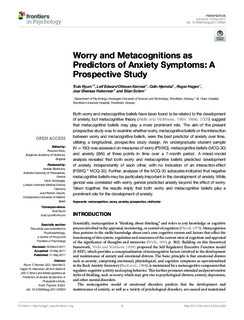| dc.contributor.author | Ryum, Truls | |
| dc.contributor.author | Kennair, Leif Edward Ottesen | |
| dc.contributor.author | Hjemdal, Odin | |
| dc.contributor.author | Hagen, Roger | |
| dc.contributor.author | Halvorsen, Joar Øveraas | |
| dc.contributor.author | Solem, Stian | |
| dc.date.accessioned | 2017-06-02T10:35:03Z | |
| dc.date.available | 2017-06-02T10:35:03Z | |
| dc.date.created | 2017-05-23T23:41:06Z | |
| dc.date.issued | 2017 | |
| dc.identifier.issn | 1664-1078 | |
| dc.identifier.uri | http://hdl.handle.net/11250/2444237 | |
| dc.description.abstract | Both worry and metacognitive beliefs have been found to be related to the development of anxiety, but metacognitive theory (Wells and Matthews, 1994; Wells, 2009) suggest that metacognitive beliefs may play a more prominent role. The aim of the present prospective study was to examine whether worry, metacognitive beliefs or the interaction between worry and metacognitive beliefs, were the best predictor of anxiety over time, utilizing a longitudinal, prospective study design. An undergraduate student sample (N = 190) was assessed on measures of worry (PSWQ), metacognitive beliefs (MCQ-30) and anxiety (BAI) at three points in time over a 7-month period. A mixed-model analysis revealed that both worry and metacognitive beliefs predicted development of anxiety, independently of each other, with no indication of an interaction-effect (PSWQ * MCQ-30). Further, analyses of the MCQ-30 subscales indicated that negative metacognitive beliefs may be particularly important in the development of anxiety. While gender was correlated with worry, gender predicted anxiety beyond the effect of worry. Taken together, the results imply that both worry and metacognitive beliefs play a prominent role for the development of anxiety. | nb_NO |
| dc.language.iso | eng | nb_NO |
| dc.publisher | Frontiers Media | nb_NO |
| dc.relation.uri | http://journal.frontiersin.org/article/10.3389/fpsyg.2017.00924/abstract | |
| dc.rights | Navngivelse 4.0 Internasjonal | * |
| dc.rights.uri | http://creativecommons.org/licenses/by/4.0/deed.no | * |
| dc.title | Worry and Metacognitions as Predictors of Anxiety Symptoms: A Prospective Study | nb_NO |
| dc.type | Journal article | nb_NO |
| dc.type | Peer reviewed | nb_NO |
| dc.source.journal | Frontiers in Psychology | nb_NO |
| dc.identifier.doi | 10.3389/fpsyg.2017.00924 | |
| dc.identifier.cristin | 1471714 | |
| dc.description.localcode | Copyright © 2017 Ryum, Kennair, Hjemdal, Hagen, Halvorsen and Solem. This is an open-access article distributed under the terms of the Creative CommonsAttribution License (CC BY). The use, distribution or reproduction in other forums is permitted, provided the original author(s) or licensor are credited and that the original publication in this journal is cited, in accordance with accepted academic practice. No use, distribution or reproduction is permitted which does not comply with these terms. | nb_NO |
| cristin.unitcode | 194,67,40,0 | |
| cristin.unitname | Psykologisk institutt | |
| cristin.ispublished | false | |
| cristin.fulltext | original | |
| cristin.qualitycode | 2 | |

